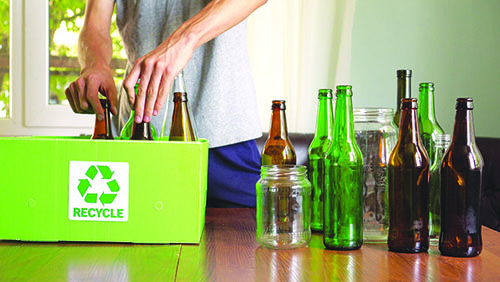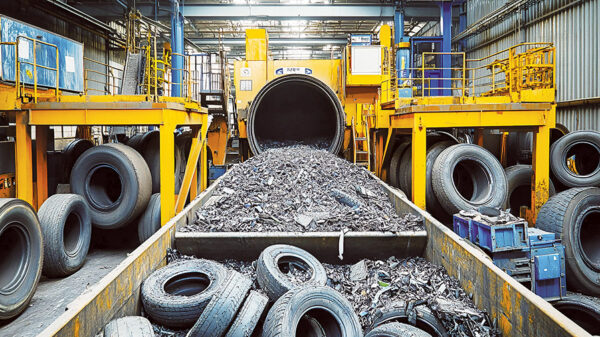by MAURA KELLER
Consider this: A shocking amount of plastic waste ends up in America’s landfills. Specifically, Americans produce about 35 million tons of recyclable plastic garbage each year, with only 10 percent being recycled.

And the amount that is recycled faces a difficult process for a myriad of reasons – including a mix of plastics with different properties, multi-layered packaging and plastic purification issues.
David Rakowski, a circular economy expert at PA Consulting, an innovation and transformation consultancy worked with the PA Consulting team to launch a report that examines how consumer packaged goods (CPG) companies and retailers are delivering sustainable plastics and packaging solutions.
“One of biggest challenges with plastics recycling is sorting and cleaning of plastics,” Rakowski said. “Mechanical recycling is the lowest energy form, lower than chemical (the emerging recycling technology). Whereas chemical will handle pollutants to a certain level and bring them back to virgin, the mechanical is far more sensitive to them.”
Rakowski pointed out that with the move to thinner plastics and films, another challenge emerges surrounding the purification of plastics in the recycling process.
“Though less energy and material is required to make the plastic – because it is thin – you have much more surface area to mass ratio so it takes more energy to clean less plastic, tipping the scales in the opposite direction,” Rakowski said. “This whole recycling business is one big systemic question, you play with something in one place and it impacts something somewhere else.”
To combat the problem of cleaning plastics, particularly plastics containing polyethylene terephthalate (PET), which is commonly used in food packaging, IBM created a technology called VolCat. This catalytic chemical process can turn PET into a renewable resource by “digesting” PET using a precise combination of chemicals, heat and pressure.
Plastic containers, bottles and PET-based fabrics are collected, ground up and combined with a chemical catalyst in a pressure cooker. Using at least 200° Celsius and a small amount of pressure, the catalyst is able to digest and clean the plastic particles, while separating containments including glue, dirt, food residue, dyes and pigments. The end product is a white power, called a monomer, which can then be fed directly into a polyester reactor to make brand new plastic products.
As IBM stated, “In the coming years, advancements like VolCat will make plastics recycling more efficient and more versatile in treating more material types than its predecessors. Unlike traditional mechanical recycling, future plastics recycling will break down both colored and clear plastics, as well as dirty and clean containers, producing a high quality final product that is 100 percent recyclable.”
For consumers, this purifying technology will mean that they will no longer have to rinse, sort and separate containers to be transformed into new and renewable material.
Biopharma Recycling
Not surprising, biopharma plastic recycling isn’t as simple as recycling ordinary plastic. In fact, approximately 30,000 tons of biopharma single use plastic products are landfilled or incinerated each year. One of the key reasons for this lack of recyclability is that biopharma plastics often contain a mixture of silicon, polyethylene and polypropylene – materials that are difficult to separate. In addition, purifying these types of plastics has also proven to be very difficult.
As Jacqueline Ignacio Hollands, global manager, customer sustainability solutions, at MilliporeSigma explained, when it comes to plastic purification, it’s important to define cleaning versus decontamination or sterilizing.
In the typical recycling infrastructure, cleaning plastics is commonly employed after plastic types are separated and then shredded. Food waste, labels and other debris are washed from the plastic shred before being further refined into a recycled plastic pellet.
“In contrast, plastic waste from the biopharma manufacturing process can often be classified as biohazardous. In these cases, “cleaning” is typically done first by autoclaving – sterilizing or sanitizing – the material, then sending it to burial or incineration,” Hollands said. “Recycling this plastic waste has been a challenge within the current recycling infrastructure due to the mixed plastics contained in the devices themselves, even when autoclaving has rendered the material non-hazardous.” Recycling the mixed plastics requires additional steps in the process or specialized equipment that doesn’t exist, so recycling these materials is not financially feasible.
MilliporeSigma’s Biopharma Recycling Program uses a shred and non-heat sterilizing process that renders the biohazardous classified material non-hazardous. This sterilized shred is then used in the manufacture of a compounded plastic lumber, all within the same location. The manufacturing process makes the recycler profitable by creating a product with greater value than the sterilized mixed plastic shred.
“Many waste ‘autoclave and shred’ systems have been on the market for years and are often found within institutions that generate regulated medical waste, such as large hospitals,” Ignacio Hollands said. “These systems are being updated, but the result is the same – create a shred that can safely go to landfill or incineration.”
There is a slight trend toward placing these systems within the biopharma manufacturing facility. Unfortunately, the challenge for recycling biopharma waste remains as the mixed plastic shred still needs to be separated before it can be recycled in the current recycling infrastructure. As a result, this shred is often incinerated.
What’s more, the newer “autoclave and shred” systems are creating a plastic shred with little to no value.
“Only when these systems are paired with separation technology is a higher value, homogenous plastic shred created,” Hollands said. “This ‘cleaner’ plastic shred can be used in the manufacturing of products containing recycled plastic content.”
However, as Hollands pointed out, using the autoclave and shred system allows for non-hazardous transportation of the waste. This could reduce costs to the biopharma facility, as shipping bio-hazardous materials is expensive. As separation technologies advance, we may see an opportunity to increase the recycling of biopharma single-use waste.
MilliporeSigma’s Biopharma Recycling Program has helped reinvigorate the conversation around sustainability in the biopharma industry.
“When the program launched in 2015, many others in the industry said that this plastic waste could not be recycled. Five years later, we’ve engaged 15 biopharma companies and recycled over 4,400 tons –and the industry is starting to take notice,” Hollands said. “In fact, many biopharma manufacturers are asking how and when they can get the process closer to their operations.”
While it is difficult to measure the impact of this program beyond the biopharma industry, Hollands says it serves as a great example of thinking out-of-the-box for recycling.
“If this challenging plastic waste stream can be recycled into plastic lumber, think of what is possible with less complex and more homogenous plastic waste.”
Published in the March 2020 Edition






